MARIANO TOMATISWONDER INJECTORItalian writer and magician
|
 Magic & AwarenessBe smark! Lucid self-delusion in Robert-Houdin’s magic Posted on friday 27 june 2014, 42 days before scifoo14 • Written by Mariano TomatisIn an article (1) dedicated to Jean-Eugène Robert-Houdin, the father of modern magic, Joshua Landy highlights the innovative aspects of his approach to conjuring. He was the first magician to abandon ceremonial robes and ritual formulas of esoteric tradition. He dressed in civilian stylish clothes, claiming the domain of science and reason on the charlatanism. His books unveiled the misdeeds of witches and cardsharpers, and his art was explicitly designed to offer new experiments divested of all charlatanism. (2) As Landy points out, he generally considered himself an active force for disenchantment, a champion of enlightenment in its continuing struggle against credulity. Nevertheless, Robert-Houdin is remembered as one of the finest (re)enchanter of his era. How could he reconcile the two attitudes? Landy illustrates the paradox by describing one of the most well-known magical effects of the French magician — the “ethereal suspension” (1847). He announced it on stage with these words: Gentlemen, I have just discovered a new, truly wondrous property of ether. When this liquid is at its highest degree of concentration, if a living being breathes it, the body of the patient becomes in a few moments as light as a balloon. After this introduction, the son of Robert-Houdin was raised in a horizontal position, supported on one side by a simple stick, demonstrating the possibility that a human being could levitate. 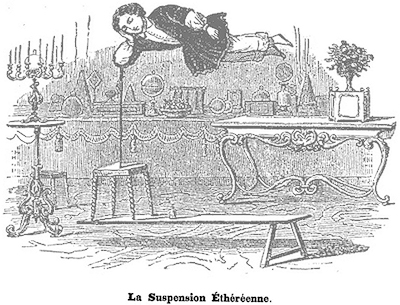 Landy comments: In order to be enthralled, then, audience members did not have to believe Robert-Houdin possessed of mystical powers, or even particularly skillful. They had only to believe in the mysteries of science. Perfectly mixing (1) the narrative context offered by Robert-Houdin at the beginning, (2) the prior knowledge of some rudiments of science and (3) the perfect execution of the experiment (which included the use of scented bottles, smelling of ether), the illusion was impeccable. Somehow, the French magician showed that, presented in the right way, the same science “used” by Enlightenment to disenchant the world — discrediting religion and superstition — was able to re-enchant it, successfully evoking a sense of wonder. Landy summarizes it by writing: Performers like Robert-Houdin, even as they demystified old superstitions, were simultaneously replacing these with new sources of enchantment — indeed disenchanting by re-enchanting. But there is more. The French prestidigitateur did not contribute to the re-enchantment of the world through science, but through an illusion of science; we must keep in mind that in his flasks there was no ether, but a colored essence just imitating it, nor the levitation was really produced by a chemical. He said to use a science (ether) but used another (which one? Secret!) — and the spell emerged from this fundamental gap. It is the same with modern mentalists: they say to use a science (NLP) but use another (which one? Secret!) — and the spell emerges. The ideal audience of Robert-Houdin had to develop sophisticated skill: to be deceived in a voluntary and conscious way. Too religious individuals (who attributed magical effects to the Devil) missed such an ability, but also those with a inadequate scientific background (actually attributing the levitation to Ether) and the cynical/militant skeptics (who labeled his performances as insults to intelligence). Landy adds that Only those spectators who, with a mental agility equal to his manual dexterity, were ready to don and doff their lucidity repeatedly throughout the show, could respond appropriately to the Ethereal Suspension. [...] What Robert-Houdin required was, so to speak, an ethereal suspension of disbelief. Aiming to shape this kind of reaction in the audience, with a true emancipatory attitude, the magician could provide valuable stimuli: his shows were opportunities to hone a detached credulity — an attitude that could be extended to daily life, re-enchanting it in its entirety. Landy called the ethereal suspension “a model for the construction of a belief system that recognizes itself as illusory”. From the point of view of the magician, it requires a lot of efforts to maintain intermediate positions, but the price paid for emancipating the audience is fully paid off by the responses of the spectators. (3) In his best selling book Sum neuroscientist David Eagleman wrote about a fascinating intermediate philosophical position, lying between faith and agnosticism. Describing himself as “possibilist,” Eagleman does not adhere to any specific religious faith — admitting that he lacks sufficient rational data to choose one or the other. This lack, which leads the agnostic to stop and suspend judgment, is not an obstacle for him: possibilists deem interesting to cultivate multiple hypotheses about the nature of the transcendent, in a creative game that fully embodies the “detached credulity.” Eagleman’s stories staged in 40 possible afterlives literally ooze irony — the key ingredient to ease in the reader a healthy detachment. Citing Friedrich Schiller, the Nobel prize-winner Orhan Pamuk labels the two categories “Naive” and “Sentimental” readers — the first unaware of the existence of tricks behind the curtain, the second lacking the ability to enjoy the illusion. I prefer the two labels used in professional wrestling, with the same meaning — “Mark” and “Smart”. Each artist can actively adopt an emancipatory attitude towards her audience, refusing the dicotomy and aiming at a “Smark” reaction. Shaping in the audience the sophisticated skill of “detached credulity” is the most ambitious challenge for a modern magician. 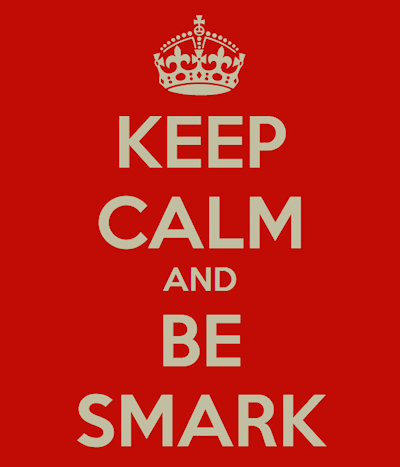 _________________ (1) Joshua Landy, “Modern Magic: Jean-Eugène Robert-Houdin and Stéphane Mallarmé” in Joshua Landy and Michael Saler, The Re-Enchantment of the World: Secular Magic in a Rational Age, Stanford University Press, Stanford, 2009. (3) Among modern illusionists, the best attempts in pursuing detached credulity are the ones by Penn&Teller, Max Maven and Derren Brown. Magic & Transmedial spin-offMy magic celebration of the TV series Lost Posted on thursday 26 june 2014, 43 days before scifoo14 • Written by Mariano TomatisOn defining fandom, Henry Jenkins wrote that it is born of a balance between fascination and frustration: if media content didn’t fascinate us, there would be no desire to engage with it; but if it didn’t frustrate us on some level, there would be no drive to rewrite or remake it. (1) Lost in Lost, I deeply experienced both the sensations when watching at the celebrated TV series created by J.J. Abrams and Damon Lindelof. My will to participate in the narrative led me to the creation of a transmedial spin-off adding a “magical twist” to the story. My website dharmainitiative.it provided the fictional context for 5 web episodes, mixing orthodox elements — i.e. coherent with the original series — and original ones (listen to the introductory audio). 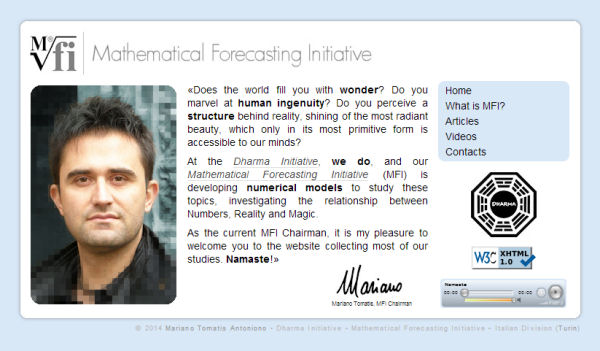 dharmainitiative.it is still available. According to the website, I had been appointed Chairman of “Mathematical Forecasting Initiative”, an organization featured in the series doing researches about the Mathematics of the Paranormal, Sacred Geometries, the role of Numbers in Magic and bizarre connections between Numerical Structures and Reality. My (actual) interest in the topic had led former Chairman’s widow to put in my hands all of the files belonged to her husband. Files included some (pretty damaged) 8 mm films presenting interactive experiments involving the viewers. Although audio tracks were missing, complete scripts of the experiments were available. The video (actually created by me) were presented as the restoration of the original footages with additional subtitles. In order to create the videos I have mixed some scenes from the TV series and original material edited by me. Inspired to the amazing Max Maven’s Mindgames (1984) — the first example of interactive magic in video — the five episodes were born at the intersection between magic and my favourite TV series. An act of love, sprung from the balance between fascination and frustration. The five episodes ★ Order and Chaos — Interactive Test #5 ★ Mathematics and Meteorology — Interactive Test #8 _________________ (1) Henry Jenkins, Convergence Culture: Where Old and New Media Collide, New York University Press, 2006, p. 247. Magic & Scientific DiscoveriesThe man who (didn’t) walk across the river Seine Posted on wednesday 25 june 2014, 44 days before scifoo14 • Written by Mariano TomatisThe philosopher and magician Martin Gardner once wrote: Just as knowing how a magic trick is done spoils all its wonder, so let us be grateful that wherever Science and Reason turn they plunge finally into stygian darkness. (1) Since Science borders with Magic, exploring its boundaries may be extremely risky. Commenting on one of the most funny blunder of 18th century, Robert Darnton asked: Man had just conquered the air; why could he not walk on water? What limits could be set to the invisible powers at the command of his reason? (2) On 25 June 2011 the British magician Steven Frayne, best known for his TV appearnces on the show Dynamo: Mission Impossible, has been seen walking across the river Thames. Many have compared Dynamo’s stunt to Jesus’ miracle (Matthew 14:22-33; Mark 6:45-52; John 6:15-21) but not many know that an engraving dated 1783 shows a similar scene; set in Paris, it represents a man walking across the river Seine. 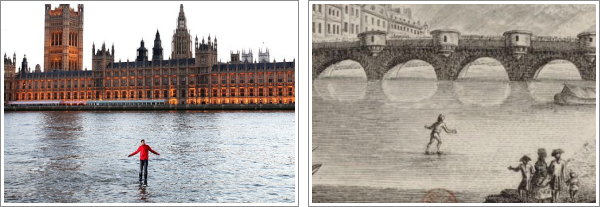 Left: Dynamo on Daily Mail (2011). Perhaps he is an ancestor of Dynamo, because he signs with the letter D. We know little about him. He is a watchmaker from Lyon, but we remember him for an amazing invention: the elastic shoes for walking on water. The idea came to him looking a mechanical little doll and throwing stones on the surface of a river. On 8 December 1783 he announced the discovery in the Journal de Paris (3).  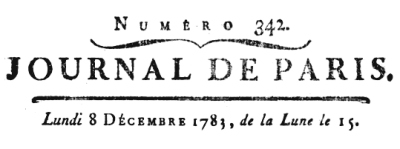 Lyon, December 1783. […] My discovery […] is the result of 20 years of work and expense. I’m flattered to have found the sure-fire way to walk with my feet dry on the surface of the water. I have discovered this looking at one of those mechanical rotating dolls that move thanks to a spring. Starting from the simplicity of this mechanism, I combined it with the principle that makes stones bouncing on the water of a river, concluding that it was possible to combine the two forces progressively, so that the resultant is able to support a weight more or less significant depending on its speed; with a motion proportional to the weight you can hold a solid object in equilibrium above a fluid. From these conjectures, I worked with the trust in the possibility of successfully implementing it, then achieving results which would not fail to arouse amazement and offer something revolutionary. I propose to traverse the length and breadth of the Seine without getting wet shoes, and to accomplish the feat multiple times on 1 January 1784 under the Pont-Neuf in Paris; but only if I will find on the other side, at the end of my journey, two hundred Louis with which to finance the trip. I am not going to exploit any other contraption except for a pair of elastic shoes, distant from one another no more than a normal step, fixed with a bar as two copper spheres. Each shoe, a foot long, will be 7 inches wide and high; with a pair of shoes like that, I can cross the wider river even 50 times in an hour. The curiosity and love for the arts and the public good will certainly encourage an adequate number of people in funding the amount of money requested, without which I can not perform the stunt. […] Signed: D…, watchmaker.  The Journal de Paris acts as guarantor for the collection of the money needed (200 Louis or the equivalent figure for 4800 livres) and in two days more than 1800 livres are collected. 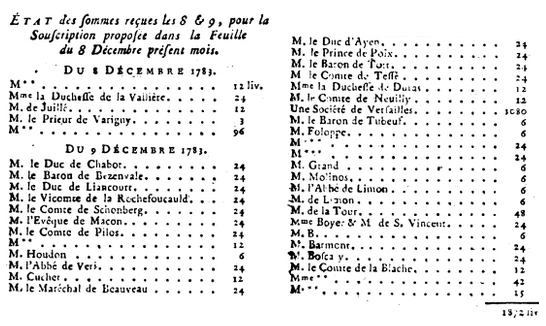 Subscription report from Journal de Paris, 11.12.1783, p. 1416. On December 13, money raise to 3243 livres and among donors there is also the famous Marquis de La Fayette, who pays 48 pounds (equal to 2 Luigi, 1% of the total). 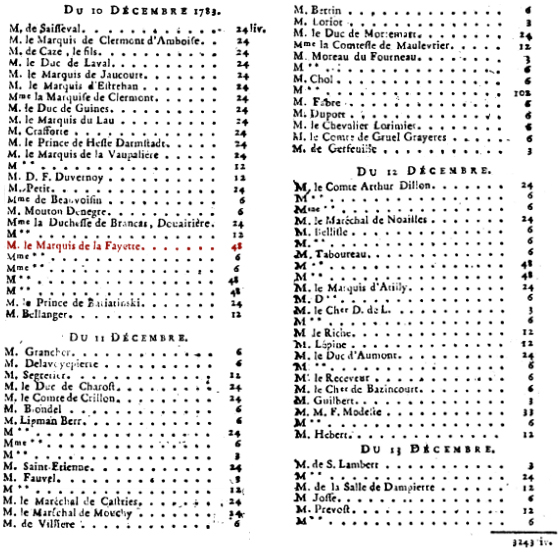 Subscription report from Journal de Paris, 11.12.1783, pp. 1436-1437. On December 18, the Journal involves the subscribers in the choice for the place from which they will watch “the spectacle of a man walking on the water” and explains that the tickets will be distributed to regulate access to the area. (4) In the meantime, P. Sellier is commissioned to create an artistic engraving of the event (5), to be offered to those who have subscribed. He imagines the scene like this:  On 22 December, the daily journal takes a step back: Monsieur De Combles, the intermediary of the watchmaker, is increasingly vague and the correspondence with him becomes every day more suspicious; the existence of Mr. D. comes to doubt, and in a letter he declares that his name was Luc (but is he writing?). According to the Journal there is enough to stop the subscription: since it is most likely a hoax, who has paid the sums is asked to return to get it back. (6) Two days later, the paper confirms that it was a sham, adding that many readers have preferred to leave the money to charities. (7) But the imagination of the artists has already been tickled, and before discovering the hoax, circulating engravings herald the scene — imagining that the protagonist will support himself with two small balloons. 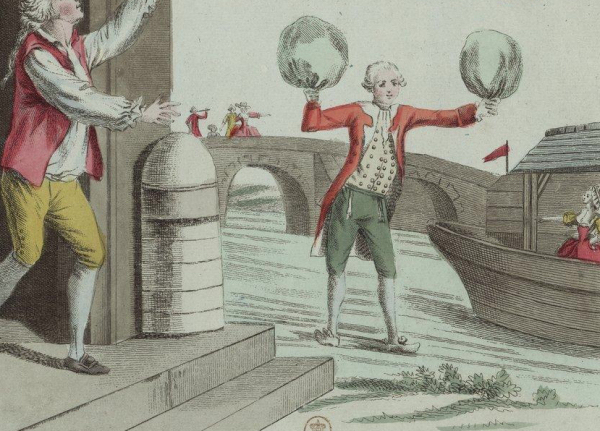 Even the Magasin Pittoresque dedicates to the event a portrait in action. (8)  Robert Darnton will comment: The burst of enthusiasm for the project, the imposing names on the list of subscribers, and the lack of precautions taken by the journal pointed to the same attitude. […] By February 7 [the journal] had overcome its embarassment well enough to print a letter promoting a technique for seeing in the dark, which was sponsored by a club of balloon enthusiasts convinced of the brotherhood of “nyctalopes, hydrophobes, somnambulists and water witchers.” (9)  _________________ (1) Martin Gardner, The Whys of a Philosophical Scrivener, St. Martin Griffin, New York 1999, p. 341. (2) Robert Darnton, Mesmerism and the End of the Enlightenment in France, Harvard University Press, 2009, pp. 23-24. (3) Journal de Paris, 8.12.1783, pp. 1404-1405. (4) Journal de Paris, 18.12.1783, p. 1448. (5) The engraving will be described as extremely rare in La Revue universelle des arts, t. IV, marzo 1857, pp. 544-547. (6) Journal de Paris, 22.12.1783, pp. 1465-1467. (7) Journal de Paris, 24.12.1783, pp. 1474-1475. (8) Magasin pittoresque, t. XIX, 1851, p. 273. (9) Robert Darnton, Mesmerism and the End of the Enlightenment in France, Harvard University Press, 2009, pp. 23-24. Magic & Graphic DesignAngelo Monne’s unexpected metaphors Posted on saturday 21 june 2014, 48 days before scifoo14 • Written by Mariano TomatisHis name is Angelo Monne and he is my favourite graphic designer. I have met him on the pages of the weekly magazine Internazionale and I have been marveled by his sketches. Never trivial, they always play with the core of the articles illustrated, focusing on unexpected metaphors or minor (and surprising) details. Angelo’s drawing I love most is on the wall of my office: it is the one illustrating the article “Combating bad science” published on The Economist. 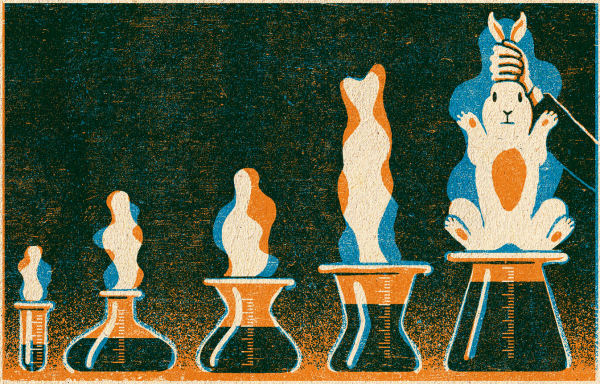 Internazionale 1045, 4.4.2014. What a lovely way to represent the hazardous mix of Magic, Science and Deception! Visit him at www.angelomonne.com: you’ll love his works! Magic & Ancient Greek LiteratureAlexander and his magic tricks in the 2nd century Posted on thursday 19 june 2014, 50 days before scifoo14 • Written by Mariano TomatisToday 450,000 Italian students of secondary school have attended their examination to get the diploma of maturità: it will grant them the right to attend university. Students from Classical Lyceum must demonstrate their learning in Greek with a written test that consists of a text to be translated into Italian. Being a centralised test, it is the same for all the institutes. Today the choice has fallen on a text written by the supreme Ancient Greek satirist: Lucian of Samosata (120-200). 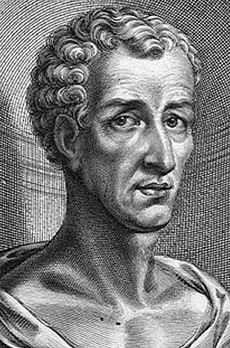 From a magician’s point of view, his most interesting work is The False Prophet, the true story of the most notorious imposter of the second century of the Christian era: Alexander of Abonoteichus. The man claimed he was in contact with a manifestation of the god Asclepius, in the form of a snake he called Glycon. Lucian describes the darkened room where his followers could meet a snake with a human head, talking to the attenders. Alexander created it by putting on a real reptile a human-like dummy head: [he] had given it a more or less human expression, and painted it very like the real article; by a contrivance of horsehair, the mouth could be opened and shut, and a forked black serpent tongue protruded, working on the same system. (1) The prophet learned of the magical arts through a friend who was a professional magician, then he started to sell fraudulent medicines, learning that humans are driven by emotions which can be easily manipulated in order to get rich quickly. Lucian’s work is full of technicalities about trickery, being one of the earliest documentary sources about the use of rational techniques to create magical experiences. Sometimes the “gaffed” snake could speak through a tube of cranes’ windpipes, which he passed, with due regard to its matching, through its artificial head, and, having an assistant speaking into the end outside, whose voice issued through the linen Asclepius, thus answered questions. (2) Working like modern audio power amplifier, these oracles were called “autophones”. Alexander could also secretly read messages with a clever trick: Alexander proclaimed that […] the God would give answers to all comers. Each person was to write down his wish and the object of his curiosity, fasten the packet with thread, and seal it with wax, clay, or other such substance. He would receive these, and enter the holy place […]; he would learn the God’s mind upon each, and return the packets with their seals intact and the answers attached, the God being ready to give a definite answer to any question that might be put. […] The trick here was one which would be seen through easily enough […] He contrived various methods of undoing the seals, read the questions, answered them as seemed good, and then folded, sealed, and returned them, to the great astonishment of the recipients. (3) …19 centuries before NSA! _________________ (1) Lucian of Samosata, The False Prophet, chapter 12. (2) Lucian, c. 26. (3) Lucian, cc. 19-20. Magic & Contemporary ArtBecoming Spider-Man? Yes, in London you can Posted on wednesday 18 june 2014, 51 days before scifoo14 • Written by Mariano Tomatis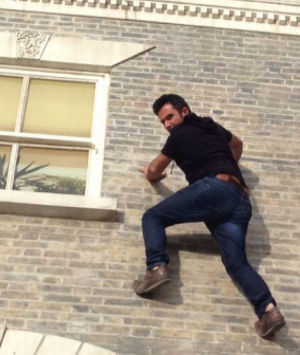 …and I suffer from vertigo! I have almost reached the top of the building, but there is something that makes me stick to the wall with safety. No radioactive spider bite: it is the force of gravity. I’m crawling on the floor, where Leandro Erlich has installed the facade of a late 19th century building: the Dalston House. A huge 45 degrees mirror is projecting my image above, where everyone can see me as I climb like Spider-Man. The installation is in London, Dalston district, and has been commissioned by the Barbican to the Argentinian artist. To build the facade, Erlich was inspired by Victorian architecture of the surrounding buildings, further strengthening the illusion. Erlich is known for his ability to transform ordinary situation in exceptional experiences through simple but striking illusory mechanisms.  Leandro Erlich, Dalston House (2013) He quotes Hitchcock, Polanski and Lynch as sources of inspiration for having used the everyday as a stage for creating a fictional world obtained through the psychological subversion of everyday spaces. (1) I lose my balance and risk of falling. My friend Ferdinando, meanwhile, is balancing on a door knob.  I capture with the phone two Eastern tourists. I duplicate the photograph and I rotate it. The result seems to come from an engraving by Escher.  Mirrors have become a classic element of Erlich’s poetics. In his “El Living” the viewer does not see his own reflection in a mirror — as it only happens to vampires. The trick involves two specularly furnished rooms, separated by a framed glass. Who walks into a room is the only one not reflected in the false mirror.  Leandro Erlich, El Living (1999) You may have the same feeling in front of his “Broken Glass”, a typical toilet with a sink, a shelf and what looks like a cracked mirror. Impossible to use it to shave: also in this case, it is just a transparent glass, behind which there is another room. The crack and the presence of two specular toothbrushes on the shelf make the illusion irresistible.  Leandro Erlich, Broken Glass (2005) I fell in love with Erlich’s work, and I totally share the faith he expresses through his works: I believe that Art and Science nourish each other. Both disciplines require Creativity to deal with Mystery. (2) _________________ (1) Emily Gosling, “A surreal, David Lynch-inspired design for Dalston House” in Design Week, 3.6.2013. (2) Jacopo Crivelli Visconti, “La invención de Leandro”, Catalogue “Fragmentos de una casa”, June 2009. Magic & LiteraturePosted on monday 16 june 2014, 53 days before scifoo14 • Written by Mariano TomatisWu Ming is a collective of Italian writers based in Bologna, best known for their best-selling novel Q, written under the pseudonym Luther Blissett (see here their website). Their main purpose is to tell stories by any means necessary, involving even the readers in the creation of transmedial spin-off. So far their works have inspired songs, theatrical performances, comics, paintings, even board games. Their latest novel L’armata dei sonnambuli (“The Army of Sleepwalkers”), set in France during the Jacobin Terror, sparks a brand new hybrid, mingling Magic & Literature. Inspired to Robert Darnton’s suggestions, the book stages an unusual conflict between Illuminist/Rational Magic and the opposite, exploring the underground influence of Mesmerism on the French Revolution. 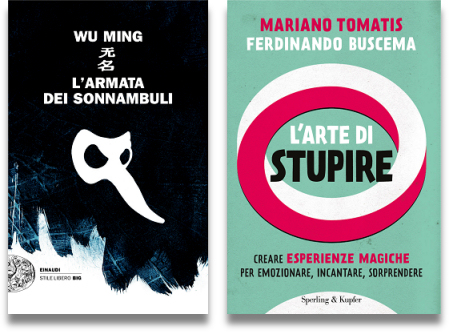 L’armata dei sonnambuli has been published one week after my book written with Ferdinando Buscema: our L’arte di stupire (“Amaze”) is the Manifesto of “Magic Experience Design” and deals with bringing magic outside the theaters and spreading it in the real world. 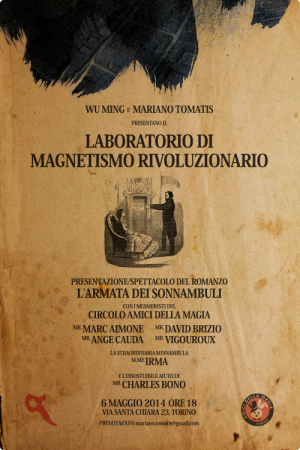 Not only the two books share the acronym of the title (L’ADS) but a subplot of L’armata dei sonnambuli follows the birth of a New Theater, far from the stage and set in the real world. Léo is one of the first to conceive the idea; the actor from Bologna thinks by himself: It was great. Here is the New Theater of Revolution. How could I come back to act an old script in a closed hall, when the theater has made History under the French sky? (1) If a magician is nothing more than a storyteller with special effects and if there is no magic trick not telling a story, literature and magic share deep roots. In order to explore the fruitful hybrid, together with Wu Ming we have created a theatrical experience — the Laboratorio di Magnetismo Rivoluzionario (“Laboratory of Revolutionary Magnetism”), presented on 6 May 2014 in the theater of the Circolo Amici della Magia in Turin, Italy. The show involved readings from the book, interactive exercises involving the audience, comments by the authors, magic tricks performed by a collective of 6 magicians and even a somnambulist with her medium in a typical Second Sight performance. (2)  A still from the first Act of the Laboratory (left) and the playbill of the show, together with the novel (right). The activity from the 3rd Act of the Laboratory is available as an interactive videogame: «Who is gonna lose the head?» is my homage to the first chapter of the novel set in 21 January 1793, the day King Louis XVI was executed by guillotine. Take out the 10 cards of spades and be ready to be mesmerized! Revolution is like those decks of cards where kings, queens and knights are divided in halves, one straight and the other inverted, head up and head down, you turn and turn it again but fuck! …nothing changes, the straight king is always paired with the inverted one, as if he was teasing him, as if — from his lower position — he was saying: «I am the you who’s breaking bad! Enjoy it until you can, ’cause the world is arbalting!» (3)  _________________ (1) Wu Ming, L’armata dei sonnambuli, Einaudi, Turin (Italy) 2014, p. 323. (2) The show has involved Wu Ming, me, Marco Aimone, Davide Brizio, Angelo Cauda, Nella Zorà, Beppe Brondino, Carlo Bono and Gianluca Gallina. (3) Wu Ming, p. 554. Magic & PoetryKnuth’s “Disappearances”: my Oulipian creative tool Posted on sunday 15 june 2014, 54 days before scifoo14 • Written by Mariano TomatisIn 1880 the Art Lithographers Wemple & Company (New York) edited “The Magic Egg Puzzle” (1), a rather curious postcard to be cut in three pieces. In the original arrangement, the picture shows a chicken with 10 eggs:  After interchanging the upper pieces, one egg has vanished:  The topic of “Vanishing puzzles” has been widely analysed by Martin Gardner. In 1981 Donald E. Knuth composed a poem in his honor — “Disappearances” (2), which incorporated the same magic properties of a vanishing puzzle.  After interchanging the right-hand portions of the poem, the eight-line verse becomes a seven-line verse. Which line disappears?  Some days ago Knuth’s poem has been featured on Futility Closet blog; in the occasion I have worked on an Italian adaptation of the text. In order to ease my task, I have created a Magic Poems Editor, an online tool which help in keeping track of the internal constraints. A rather Oulipian exercise! My creative tool for playing at the intersection between Magic and Poetry is free and available here. 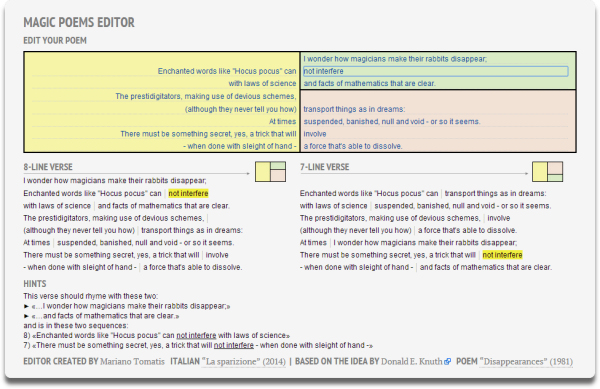 If you come across an excellent poem (or a good adaptation in a foreign language), please share the results with me: I will publish them! _________________ (1) Martin Gardner, Wheels, Life, and Other Mathematical Amusements, W.H. Freeman and Company, New York 1983, p. 129. (2) D.A. Klarner (ed.), The Mathematical Gardner, Wadsworth International, Belmont (California) 1981, p. 264. Magic & Flying SaucersPosted on saturday 14 june 2014, 55 days before scifoo14 • Written by Mariano TomatisBalancing Heart and Mind is a crucial purpose to human existence, according to gurus, philosophers and religious leaders. Much more rarely, to scientists. Often the idea is advocated vaguely, without any reference to a good practical example. Here is a curious and compelling story, which begins on the French Riviera and ends in Stockholm. It involves flying saucers, an old IBM 1620 and a suitcase that goes around the world, showing how Mind and Heart can effectively cooperate. The artist: Jean Cocteau (Step 1) It is 1954. Jean Cocteau and Aimé Michel are sipping a Pastis in villa Santo Sospir in Saint-Jean-Cap-Ferrat.  Park of villa Santo Sospir in Saint-Jean-Cap-Ferrat, France. They talk about their common love: flying saucers. One of Cocteau’s portraits reminds of some constellations: joining together some points, he drew the picture of a face. 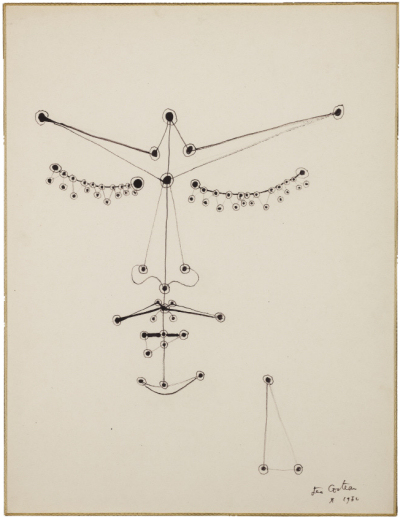 Jean Cocteau, “Orphée aux yeux Perles” (1950). Being a good visionary, Cocteau looks at the portrait and sees a starry sky. And in the hand drawing the lines, the trajectory of an aircraft. It is the true vocation of the artist: pure intuition. His hypothesis: flying saucers communicate with us by drawing sketches in our skies. Addressing his friend, Cocteau suggests: You ought to see whether the objects move along certain lines, whether they are tracing out designs, or something like that. You might try to discover, for instance, whether their movements coincide with magnetic lines of force, or with any other lines in a significant way. (1) The scientist: Aimé Michel (Step 2) Aimé Michel must translate Cocteau’s intuition in a testable hypothesis. It is the true vocation of science: to express an idea with mathematical symbols — the language spoken by Nature. On September 24, 1954 in France there is a sudden wave of UFO sightings. Michel takes a globe and puts a pin on each of the cities involved (Bayonne, Lencouacq, Tulle, Ussel, Gelles and Vichy), realizing that they are aligned. Hypothesis: UFO sightings recorded in a day are always arranged in a straight line. Michel calls “orthoteny” the idea and describes it in his book Flying Saucers and the Straight-Line Mystery (2) 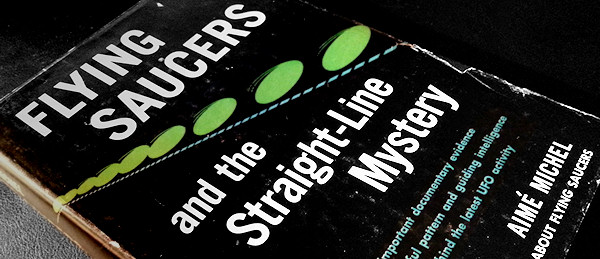 The judge: Jacques Vallée (Step 3) Jacques Vallée is also a scientist. With his knowledge of statistics, he is able to test the fascinating “orthotenic hypothesis”. In 1962, he collects hundreds of sightings in a rudimentary database running on IBM 1620.  Not only he detects alignments: he is aware that they may appear by chance. He compares their number with the one emerging when throwing catnip seeds on a geographical map. It is the true vocation of the statistician: detecting anomalies and assessing whether they are (or not) emerged by chance. The numbers speak by themselves: orthotenic hypothesis does not hold. Falling in love with Cocteau’s vision is the first step. Admiring the rigor of the hypothesis proposed by Michel is the second step. Accepting that the hypothesis is wrong demands an uncommon detachment: it is a third (but not last) step. 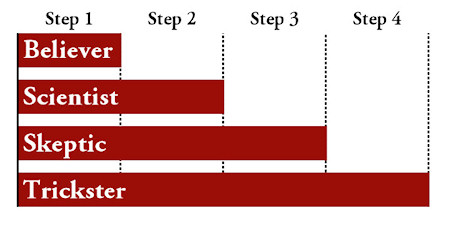 The trickster: Erik Nordenankar (Step 4) Cocteau’s intuition and Vallée’s skepticism are not mutually exclusive alternatives. The interaction between the two may be a huge creative stimulus. Erik Nordenankar grasps it immediately. The surrealist epic of a planet on which to draw, in no way is menaced by the demonstration that — no, aliens are not communicating with us. On the contrary, it is an invitation to roll up our sleeves and start to draw by ourselves. Nordenankar puts a GPS device in a suitcase and plans a series of shipments via DHL, sending it around the world long a twisted path crossing more than 60 different countries. Telling the story, the Swedish artist will say: The suitcase became my pen, the world my paper. (3) Tracing the route of the suitcase with GPS, within 55 days Nordenankar draws the biggest self-portrait ever: 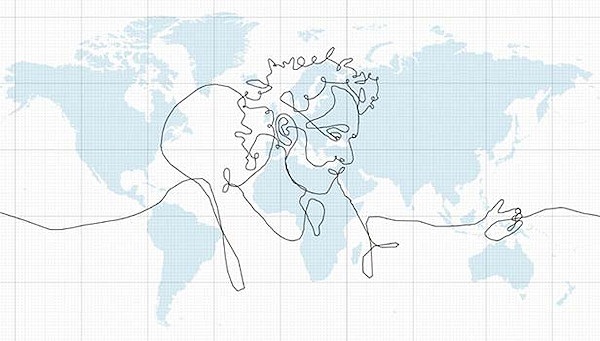 But the true nature of Nordenankar is that of the trickster, whose true vocation is to confound, wreaking havoc and playing with chaos. His actual work is this video, documenting in detail the project: As revealed by Matthew Moore in The Telegraph, nothing is real in the video. (4) No shipping, no involvement of DHL, no GPS device. Just a good idea, through which injecting Wonder and suggesting a unusual contamination. The performance of those who can take the fourth step. Cocteau’s poetic intuition is irresistible. Michel frames it mathematically in the best way. Vallée shows its inconsistency with crystalline honesty. Only grasping the genius in each of them Nordenankar can go further, hacking reality and bringing to completion — through an elaborate illusion — an intuition too good to be false. _________________ (1) Aimé Michel, Flying Saucers and the Straight-Line Mystery, Criterion Books, New York 1958, p. 51. (2) Aimé Michel, Flying Saucers and the Straight-Line Mystery, Criterion Books, New York 1958 (3) Erik Nordenankar, “Biggest Drawing in the World”, YouTube, 15.5.2008. Many thanks to Davide Brizio. (4) Matthew Moore, “’Biggest drawing in world’ revealed as hoax” The Telegraph, 27.5.2008. Magic & ActivismMesmeristic treatments and artistic barricades Posted on friday 13 june 2014, 56 days before scifoo14 • Written by Mariano TomatisThe world’s soccer tournament kicked off yesterday in Brasil, with scattered protests around the country coordinated by the Não Copa (No Cup) Movement. Hundreds of protesters are railing against the $11.5 billion spent by the government to host the event, arguing that money could have been better used. Social movements always face questions of tactics and strategy, and dilemmas may derive from the issues the protest has chosen to emphasize. The (far from obvious) commitment to nonviolent civil disobedience as a primary method of protest may lead to frustration those who argue the necessity of violent actions — and viceversa. In the last few years Italy has hosted an interesting laboratory: subject of the dispute is the Turin-Lyon high speed rail project, a $50 billion “Grande Opera” considered by many a senseless squander of public money — in a country where we are still paying a fuel tax to finance the Italo-Ethiopian War fought by Benito Mussolini’s Fascist army in 1935-1936. The project involves also the excavation of two twin tunnels, each of them 35-mile long and 20-foot wide, with a huge environmental impact. So far the indomitable NoTAV (i.e. NoHSR, No High-Speed Rail) opposition has created a strong network of solidarity all over the country, in front of the increasing militarisation of the Susa Valley. 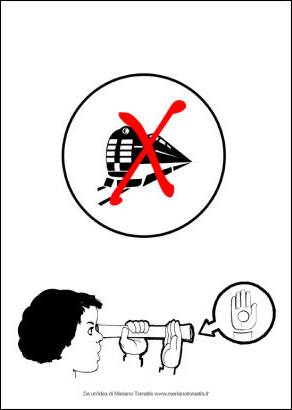 Involved as a magician in a NoTAV event organised to raise awareness about the dispute, I designed a leaflet — a typical tool for propaganda — incorporating a rather unusual narrative layer with magical implications. In a world literally overloaded of informative leaflets, the purpose was to make it sticky, in the spirit of the bestselling book by Chip and Dan Heath Made To Stick, a book seeking to explain what makes an idea interesting and memorable. On one side of the leaflet, a logo of the NoTAV campaign surmounted the strange image of a child holding a tube as a telescope. I distributed dozens of leaflets, explaining that they were therapeutic tools for the cure of a psychiatric disorder: the irrepressible (Freudian?) boost of destroying mountains and digging tunnels through solid stones, in order to assert virility and going faster and faster. In the historical tradition of mesmeristic treatment, the relief comes from an hallucinatory image produced through the leaflet, without the need of any chemical drug. Roll it and put it in front of your left eye with your left hand, as if holding a telescope. Open the right hand with the palm facing you and put it close to the tube, approximately 6 inches from your nose. Keep your eyes both open and look a point far at the horizon: a tunnel will appear in the middle of your right palm! Administer this hallucination to someone suffering from the disorder, commenting: «Do you see the tunnel through your hand? Be satisfied with it, because it is the only tunnel you will ever see!» 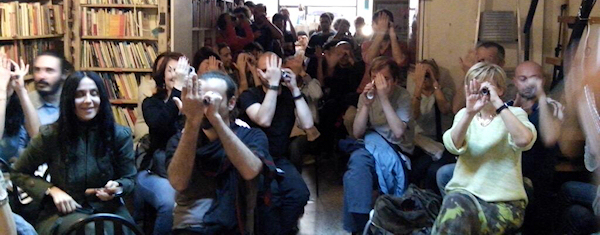 My audience in a bookstore, mesmerised by the NoTAV treatment. Modo Infoshop, Bologna (Italy) on 9 May 2014. The second side of my leaflet showed a hacked version of a popular Italian painting: Il quarto stato (“The Fourth Estate”) by Giuseppe Pellizza dal Volpedo, a truly icon of the twentieth century, showing striking workers.  The original painting (left) and my hacked version on the other side of the NoTAV leaflet (right). In my version the main three characters are dressed like a clown, a magician and a fairy (zoom here). The subtext: magic should return to the people. The NoTAV treatment (Novissima Oculistica Terapia Allucinatoria Visiva, i.e. Brand New Optical Therapy of Visual Hallucination) is but one of the oblique approaches to activism inspired by the work of Wu Ming Foundation, “a collective of militant storytellers opposing the toxic narratives that create fear, prejudices and inequality” — as the New Statesman defined them (here). In commenting this approach to magic and activism, Wu Ming wrote: Those magicians [...] will not be an élite: those magicians will be us, all of us, no close caste of wisemen, no übermensch, magic to the people! Outside the narrow spaces of theaters and clubs, out of the less and less magical TV box set, out of the caverns of obscurevoyant and psychics, enchantment and awareness can — and must — come together again, to enrich life, to dance with eleven legs, to tell stories and to enliven them by any means necessary. (1) Blu’s artistic barricade Another action inspired by the group of writers, also using wonder and surprise to oppose senseless urban projects, was signed by Blu, a Bologna-based artist known for his large-scale paintings (one of the 10 best living street artists, according to The Guardian). In order to create a roundabout to ease the traffic towards a commercial center, in 2012 the Municipality of Bologna deliberated the destruction of Xm24, a popular social center run in the spirit of co-operation and mutual aid. At the beginning of 2013 Blu contributed to the protest against the project with an astonishingly huge painting on a wall of Xm24. His work was so beautiful and stunning that Municipality was forced to alter the original project and change the location of the roundabout, resigning from the destruction of the social center. Wonder has prevailed over money. The theme of the painting is an apocalyptic conflict between Evil (impersonated by members of Municipality, police and higher classes) and Good (impersonated by multitudes of people living in the suburbs). The Tolkenian symbology behind the painting was inspired to Blu by some articles written by Wu Ming, dedicated to the political implications of the epic in The Lord of the Rings. The successful “artistic barricade” inspired a public event in front of the murales. “Occupy Mordor” took place on 14 April 2013. In the occasion, more than 600 people came to visit the work of art and during the evening Wu Ming 4 illustrated its symbology and subtleties with a learned lecture (Italian audio and video here). 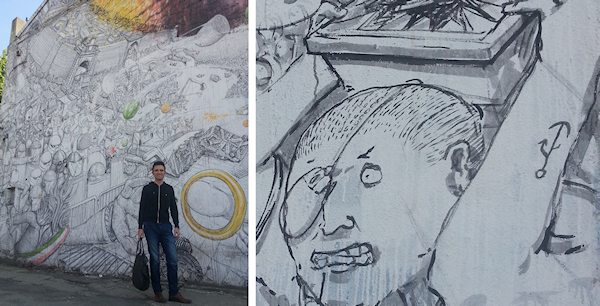 Me and the Evil side of Blu’s murales (left) and a detail from the Good side of the painting: a modern pirate with a mouse/eyepatch and a tattoo representing a anchor/USB port (right). _________________ (1) Mariano Tomatis and Ferdinando Buscema, L’arte di stupire, Sperling & Kupfer, Milano 2014, back cover. Magic & EconomyExperientializing goods with magic Posted on thursday 12 june 2014, 57 days before scifoo14 • Written by Mariano TomatisIn a society where products and services are more and more becoming alike, the ability to surprise a customer beyond any rational argument makes a difference. In this scenario, magic — and the surprise it evokes — may be a valuable marketing tool. To describe the idea behind it, in our book L’arte di stupire (“Amaze”) me and Ferdinando Buscema use the image of coffee proposed by Joseph Pine II and James Gilmore in The Experience Economy. The handful of beans necessary to make a cup of coffee cup, earn a farmer one or two cents. When the manufacturer grinds, packs and sells them in the supermarket, the cost of the coffee cup rises to about 25 cents. Served at the local bar, its cost reaches one dollar. However, when served in a luxurious environment — as in a theater or a renowned restaurant — it’s no surprise spending three dollars for a coffee. At the Cafe Florian in Venice, Italy a cup of coffee is inseparable from the playing orchestra — total cost: $15. The good sold is always the same, but the farmer offers it as a commodity, the supermarket as a consumer good, the bar as a service and the Venetian venue as a part of an experience. These four types of offers have different values in the customer experience. 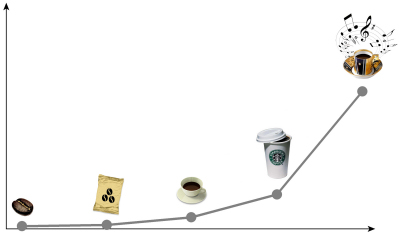 Nowadays goods and services are no longer enough, and a new kind of offer emerged: that of the experiences, occurring whenever a company intentionally uses services as the stage and goods as props to engage an individual. In the “Experience Economy” (1), a company not only provides a good or a service, but also all of the feelings that come together with it. Shifting the focus from the product to the customer, companies seek to enhance the experience of the user, care for it and make sure it will remain in memory. Minting a new effective verb, Pine and Gilmore wrote that manufacturers must explicitly design their goods to enhance the user’s experience as well — essentially experientializing the goods. (2) But what does that mean in practice? Our work for Moleskine In March 2013 we organized the event TEDxNavigli “The Power of Love”, focused on the implications of love in art, business and society at large. For such occasion, the company Moleskine involved us in the design of a notebook to be in theme with the event. Using the rubberband that keeps the notebook closed, we hacked the object, adding an unexpected function. Reflecting on the quote by Martin Luther King Love without Power is sentimental and anemic we printed on the cover three logos: on the two ends, the “power” icon and a “heart” icon (standing for “love”), in the middle, a hybrid icon that ideally put them together.  At rest, the rubberband is positioned on the heart. To move the rubberband on the power icon it requires a remarkable strenght of a finger. With less effort, you can keep the band on the central symbol, getting the right mix of power and love. 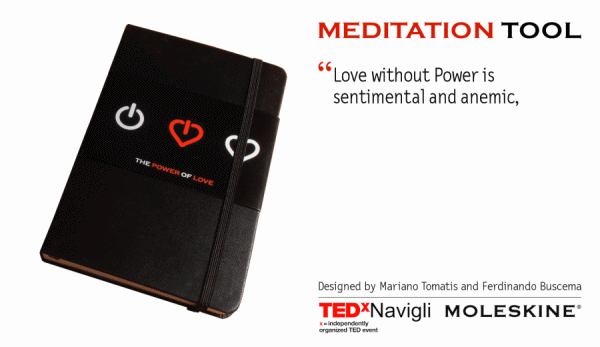 As written on the inner band of the Moleskine notebook, across science and magic: To keep the elastic band on the central symbol you need a force of 1.618 Newtons. That number is the Golden Ratio, an ideal of harmony and the principle of natural and artistic phenomena. By incorporating this universal constant, this Moleskine notebook will allow you to reflect on the Power of Love — a pillar of the harmony of the spheres since time immemorial. This is just one way to “experientialize” a good. In order to add an unexpected function to an object it is necessary to create an original story that involves an unusual detail. Combined with the curious cover art, the Moleskine elastic band turns the notebook into a “tool for meditation” (see it in the official blog). On several occasions we’ve been asked if, in principle, it is possible to turn any object into a magical one. Paraphrasing Douglas Hofstadter, one can not be so arrogant to say yes, but we trust in the possibility — starting from any object — to identify an unexpected and surprising angle from which to look at it, making something magical happen. Using magic to discourage consumerism Besides being a marketing tool, like a knife cutting both ways, magic can be used in the opposite direction. Are you horrified (like me) by people camping at night in front of big stores, to be the first who will buy the brand new mobile phone next morning? Enjoy the incredible experience designed by Improv Everywhere involving the owner of a 99 cent store in Manhattan. A truly subversive (and magical) poetry! _________________ (1) The term was firstly proposed in Pine II, B. Joseph e Gilmore, James H., “Welcome to the Experience Economy”, Harvard Business Review, July/August 1998, pp. 97-105. (2) Joseph B. Pine II and James H. Gilmore, The Experience Economy, Harvard Business Press, 2011. Magic & PoliticsSawing a woman in half? A political message Posted on wednesday 11 june 2014, 58 days before scifoo14 • Written by Mariano TomatisMagic tricks may have profound (and unexpected) implications — even political. Let’s consider the classical “Sawing-a-woman-in-half” illusion. It was presented for the first time in 1921 by Percy Selbit. Women’s suffrage had just been granted, but in the patriarchal society of those years, the supporters of the vote to women were treated as dangerous terrorist. As a provocation, Selbit offered 20 pounds to their leader Sylvia Pankhurst to cut her in half.  The Magician Monthly, N. 2, Vol. XVII, January 1921. The woman refused indignantly, but the newspapers spreaded Selbit’s irony: What a chance for Selbit—to be able to say he has actually “sawn off” the redoubtable “Sylvia”, not once, but many times! (1) For Percy and his audience, sawing a woman in half was a political message. Rage over Sylvia mean holding off a figure that would claim the same rights as a man. Even today such a representation of a femicide is hardly blameless. Lucy Fischer contested that this was just a game. In an article on the role of women in magic she asked: If the male magician only wished to “play” with the female subject, why has he devised for her such a chamber of horrors? (2) Actually, leafing through magic catalogs may reveal cruel gizmos like this: 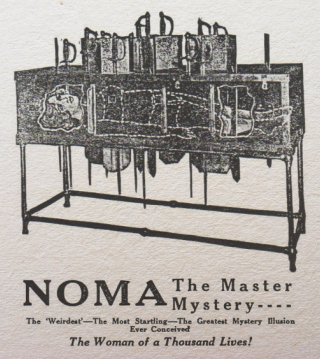 My 13-minutes documentary “Donne a metà” (“Women In Halves”) tells the story of this illusion from George Méliés up to our days, investigating the political implications of stage magic and inviting us men to tear away from our flesh the call of violence and the taste of oppression evoked by these narratives. (Embedded English subtitles available.) _________________ (1) The Magician Monthly, N. 2, Vol. XVII, January 1921. (2) Lucy Fischer, “The Lady Vanishes” in Film Before Griffith, University of California Press, Los Angeles 1983, p. 345. Magic & TechnologyTechnological magic: the short story of Google Mind Posted on tuesday 10 june 2014, 59 days before scifoo14 • Written by Mariano TomatisAs a magician with an academic background in Computer Science, the probability of me citing Arthur C. Clarke’s Third Law in a post (“Any sufficiently advanced technology is indistinguishable from magic” (1)) is dramatically high. I’ll keep you safe from the risk, illustrating a practical example of how Clarke’s Law may inspire a truly magic technology — or a truly technological magic.  At the beginning of 2010 I was working on the ability of reading while blindfolded (the psychic power the Burdin Prize was based on). When presented in a theatrical context, its surprising plot can be summarized in few words: the magician is able to get pieces of information stored out of his sight. At the royal court of Ramses, knowledge was sealed in papyri: at the time, the proto-mentalist Siosiri performed before the pharaon reading a papyrus without opening it. (2) The same performance was labeled “Book Test” (3) when printed books started to be involved. No matter where information was: mentalists have always been able to get it in a magical way. Studying past trends is the best way to predict the future: in a while, magic stores will sell e-book tests and one day mentalist will connect their mind directly to the Internet, where information is stored today. The best way to predict the future is to create it: I had the idea of using Ajax (Asynchronous JavaScript and XML) as a dæmon working for me behind the curtains and helping me to (apparently) connect my brain to the electromagnetical waves surrounding my head. A website exploiting Ajax takes advantage of downtime to anticipate calculations, with the purpose of offering the user a higher speed and a better experience of interactivity. Like in a magic show, the dirty work is done out of sight. With the help of this dæmon I created Google Mind. Googling with the power of the mind Open google.com in your browser and invite a friend to write any string in the input box — e.g. the name “Obama”. Before clicking Search, you connect to the search engine with your mind and announce: «Googling “Obama” you will get about 224 millions results.» When clicking Search, Google confirms: there are about 224 millions results. The truth? The engine you are using is not the original one, but an enhanced mirror. As soon as your friend has written her string in the input box, before clicking “Search” the sneaky Ajax googles it and parses the resulting page, extracting the number of occurrences of the string. That number appears for a second in the bottom right corner of the screen; you just need to glimpse and announce it in a mysterious fashion, as if it came from your “animal (electro)magnetism”. 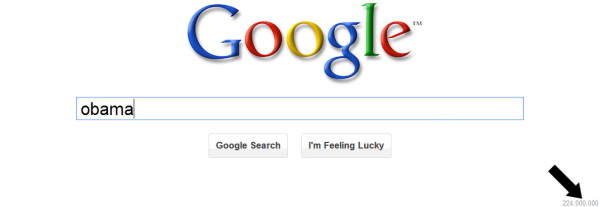 My (unauthorised) Google Mind (April 2010). It worked for a while. And I enjoyed to perform it before the astonished eyes of my friends. Someone said that magic is merely technology ahead of its time. The Magic Mirror in the story of Snow White was conceived centuries before flat-screen TV. Aladdin’s Magic Carpet flew long before Wright brothers. The Lamp of the Genius could be activated by swiping — the same gesture used to unlock modern smartphones. Announcing Google Instant on 8 September 2010, Google confirmed it. The new functionality made search fast by showing results instantly as one typed. And yes, Google used the same dæmon which had worked for my magic trick. Google Mind was — in a way — “embodied” in the official search engine, forcing me to explore new ideas and to conceive even more remote futures. _________________ (1) Arthur C. Clarke, “Hazards of Prophecy: The Failure of Imagination” in Profiles of the Future: An Enquiry into the Limits of the Possible, 1962, p. 36. (2) See the Setne Papyrus at British Museum, London. Its translation is available here in Francis Llewellyn Griffith, Stories of the High Priest of Memphis, Clarendon Press, Oxford 1900. (3) William Stainton Moses, Spirit Teaching, London Spiritualist Alliance, London 1898, p. 32. Magic & HypnosisMagic and hypnosis: keeping trickery out of the door Posted on monday 9 june 2014, 60 days before scifoo14 • Written by Mariano Tomatis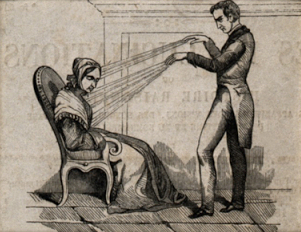 Intersections are fascinating areas. In the region between Science and Magic you can stumble upon Hypnosis, a fascinating and controversial topic. Originating from Mesmerism — a practice based on a (hypotetical) invisible natural force exerted by animals, the “animal magnetism” — it became part of medical science with James Braid (1795-1860), who coined the term “hypnotism” (1). Interestingly, Braid started suspecting fraud, but upon witnessing astonishing results (and after making certain tests on the magnetized subjects himself) he became convinced the phenomena were genuine. Part of his skepticism was well-grounded. In addition to its medical applications, Mesmerism ispired theatrical performances in which stage magnetists used magic tricks to simulate the effects of hypnosis. After two centuries, it is still difficult to draw a clear line between ordinary suggestion and the so called “hypnotic trance”. Working together with psychologists, a well trained magician may be extremely helpful in sorting out the intricate combination of the factors influencing hypnosis — on a stage, but also in research institutes — both psychological (such as participant selection, ordinary suggestibility, peer pressure and social compliance) and physical (involving stagecraft, manipulation, and trickery). My book Te lo leggo nella mente (“I read it in your mind”) is a wide analysis of this liminal area. Two little holes in the taffeta Long before James Randi’s One Million Dollar Paranormal Challenge, in 19th century the Parisian Académie Royale de Médecine offered 3,000 Francs to anyone who could demonstrate the ability of reading while blindfolded during an hypnotic trance. On 5 September 1837 Claude Burdin announced: If we find one that can read without the aid of light, eyes and touch, I propose to give him a price of three thousand Francs. I am personally committed to pay this sum, I will deposit in the hands of a notary, and a commission of the Academy will monitor, determine, direct, judge the tests; and after their report, the Academy will award the prize to the subject that has deserved it. (2) 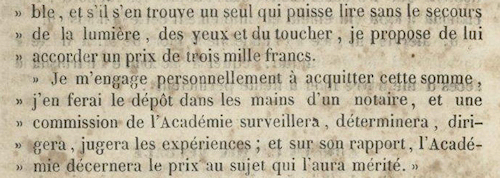 E. Pariset, L.-Ch. Roche e J.-B. Bousquet, Bulletin de l’Académie Royale It is really funny to read about the daring adventures of the competitors. The eleven year old daughter of Pigeaire, a veterinary from Montpellier, was tested on 7 July 1838. Between tears and “contortions of the muscles of her face,” (3) the blindfolded girl read two stanzas of a poem from a book opened at random. Checking the fabric of taffeta with which she had made the bandage, two members of the Academy “discovered two little holes” and revealed the fraud.  «Two Academy members, at the end, by checking the taffeta discovered two little holes; they raised the suspicion that the somnambulist was looking through them.» in “Premi proposti dalla R. Accademia delle scienze di Parigi”, Biblioteca italiana ossia giornale di letteratura, scienze ed arti, Vol. 92, Milan (Italy), October-December 1838, p. 139. Hypnosis beyond trickery Studies about hypnosis have improved a lot during recent decades, keeping trickery out of the door and focusing in identifying types of high hypnotizables individuals. Starting from the two subgroups identified by Deirdre Barrett (“fantasizers” and “dissociaters” (4)) I stumbled upon her recent works about the contributions of dreams to creativity and problem solving — and I felt like a dog with two tails. And the tails became four when I read about her studies on “supernormal stimuli” — artificial objects pulling an instinct more strongly than that for which they evolved. For their role in governing the behavior of humans, they are really interesting from the point of view of a magician, using technology and trickery to enhance the state of Wonder in the audience by steering (and misdirecting) perceptions. Supernormal stimuli have a counterpart in the idea of hyperreality and the inability to distinguish reality from a simulation of reality is at the very core of a magic experience properly designed. _________________ (1) James Braid, Braid on hypnotism. Neurypnology, George Redway, London 1899. (2) «[…] s’il s’en trouve un seul qui puisse lire sans le secours de la lumière , des yeux et du toucher, je propose de lui accorder un prix de trois mille francs. Je m’engage personnellement à acquitter cette somme, j’en ferai le dépôt dans les mains d’un notaire, et une commission de l’Académie surveillera , déterminera , dirigéra, jugera les expériences ; et sur son rapport, l’Académie décernera le prix au sujet qui l’aura mérité.» in E. Pariset, L.-Ch. Roche e J.-B. Bousquet, Bulletin de l’Académie Royale de Médecine, Tome II, J.-B. Baillière, Paris 1837-1838, p. 19. (4) Deirdre Barrett, “The Power of Hypnosis”, Psychology Today. Magic & CulturePosted on sunday 8 june 2014, 61 days before scifoo14 • Written by Mariano TomatisRule #34 is an adage which asserts that if something exists on the Internet, there is porn of it. On 2006 the rule was submitted in the satirical Encyclopedia Dramatica together with an addendum: Rule 34: There is porn of it, no exceptions. I’m an Italian writer and magician who has been invited to participate to the Science Foo Camp 2014 (scifoo14) taking place at the Googleplex in Mountain View, CA. Why me — an illusionist — among researchers, educators, artists, policy makers, investors, and other thought leaders? Maybe for my daily commitment in working for a better Rule #34, going like this: If it exists, there is magic of it. If not, let’s make it! Is there room for magic in the contemporary cultural debate? I acknowledge that today the magician is an old-fashioned figure. With his balloon sculptures, gaudy handkerchiefs and doves, his aesthetic evokes the pastimes of childhood and village feasts.  L’Illusionniste (France, 2010). David Metcalfe frankly commented: When one thinks of stage magic, speculative metaphysics might not be the first thing that comes to mind. (1) David wrote it after his meeting with Max Maven, the contemporary magician who — more than anyone else — has elevated the secular magic to a form of modern art, highlighting its deep philosophical and cultural implications. One of the most prolific theorists on the subject, in an article on the role of magic in the U.S. cultural context Maven commented bitterly: Three magicians showed up on Forbes magazine’s recent list of the highest paid American entertainers. However, when Newsweek shortly thereafter did a cover story on the one hundred most influential people in American culture there was no one even remotely resembling a conjurer on the list. Conclusion: They’ll pay us, but they won’t listen to us. (2) Are there the basis for acknowledging to magic a role in the contemporary cultural debate? My efforts are all focused on this purpose: improving the perception of magic in public opinion, believing in the possibility of emancipating magic from mere entertainment to a “category of thought.” Showing its implications in science, arts — even in politics — will be my contribution to scifoo14. _________________ (2) Max Maven, “Scrooge et Noir” in Magic Magazine, december 1992, p. 16. |
 Science Foo Camp (or “Sci Foo”) is an invitation-only gathering organized by Digital Science, O'Reilly Media, and Google, with support from Nature. The 9th edition of Sci Foo takes place on 8-10 August 2014 at the Googleplex in Mountain View, CA. Lord Martin Rees has defined it as “a sort of mini Woodstock of the Mind”. Participants include researchers, writers, educators, artists, policy makers, investors, and other thought leaders, all doing groundbreaking work in diverse areas of science and technology.
Science Foo Camp (or “Sci Foo”) is an invitation-only gathering organized by Digital Science, O'Reilly Media, and Google, with support from Nature. The 9th edition of Sci Foo takes place on 8-10 August 2014 at the Googleplex in Mountain View, CA. Lord Martin Rees has defined it as “a sort of mini Woodstock of the Mind”. Participants include researchers, writers, educators, artists, policy makers, investors, and other thought leaders, all doing groundbreaking work in diverse areas of science and technology.